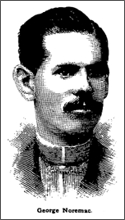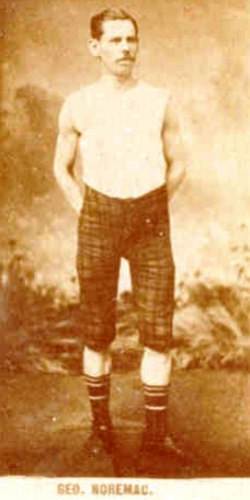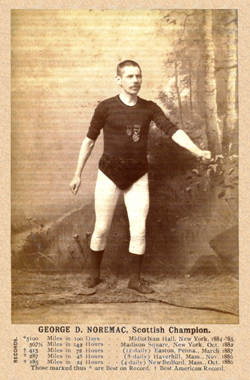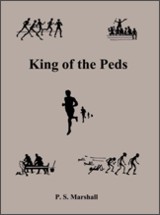The Flying Scotsman
 Once in a while in the world of sport, someone really special turns up. One such person was a professional Scottish pedestrian called George D. Cameron.
Once in a while in the world of sport, someone really special turns up. One such person was a professional Scottish pedestrian called George D. Cameron.
A lithographer by trade, Cameron stood 5ft.3½ inches and weighed in at about 8st.10lb. Born in Edinburgh on the 18th of May 1854, George decided that if he really wanted to stand out amongst the crowd, he needed a professional name – and found it by simply spelling his surname – backwards!
"Noremac" would become one of many hardy athletes who entertained huge crowds at sporting venues worldwide by walking and running ultra long distances in pursuit of generous prize money and ornamental gold belts.
Edward Payson Weston, of Providence, Rhode Island, who was also known as the "father of pedestrianism" would be the man to provide the inspiration for the phenomenon known as the "Pedestrian Mania" which reached its dizzying height in 1879. From the Pacific west coast of America to Europe to New Zealand, thousands upon thousands of excited fans screamed themselves silly as they witnessed the sporting spectacle of the Victorian period.
And it wasn't just the sight of scores of rugged men dressed in an array of colourful costumes making their way around sawdust tracks for up to six days and nights which captured the hearts of the sporting public either – some of the participants were quite eccentric – "Old Sport" Campana from Bridgeport was a real favourite because of the unusual antics he performed on-track. Frank Hart, the "colored" champion from Boston also "wowed" the crowds because he was "different" and the Irishman, John "Lepper" Hughes, also created quite a stir because of his passionate attitude to the profession he served.
The financial rewards for the most successful "peds" were huge. For winning just two races in New York, the "Cambridge Wonder", Charles Rowell, from England, managed to secure prize money totaling an incredible $50,000!
 In his formative years as an up-and-coming "pro", Cameron proved himself as a handy runner at shorter distances. Winning prize money of up to £20 at a time, he consistently finished in the frame in races ranging from one mile handicaps to 4-hour events over six days all over Scotland, which included events at the Aberdeen Recreation Grounds, the Powderhall Grounds and the Royal Gymnasium, at Edinburgh, the Shawfield Grounds, at Glasgow and the Drill Hall, at Perth.
In his formative years as an up-and-coming "pro", Cameron proved himself as a handy runner at shorter distances. Winning prize money of up to £20 at a time, he consistently finished in the frame in races ranging from one mile handicaps to 4-hour events over six days all over Scotland, which included events at the Aberdeen Recreation Grounds, the Powderhall Grounds and the Royal Gymnasium, at Edinburgh, the Shawfield Grounds, at Glasgow and the Drill Hall, at Perth.
But it wasn't till the early part of 1880 when his long-distance career really started to take off. Incredibly, in late February and early April of that year, Noremac somehow managed to muster a straight hat-trick of victories in 72-hour (12 hours a day "go-as-you-please") competitions beginning at Newsome's Circus in Glasgow, with a score of 357 miles, and ending up by making a new 72-hour world record of 384 miles in the Show Hall at the Royal Gymnasium, in Edinburgh. Noremac's last mile, which was timed at 6m.30s., would secure him the £40 first prize money.
Before this momentous five weeks, the "Flying Scotsman", as he was affectionately known, raced in a six hours per night, seven-day "pedestrian contest" at Nottingham, which commenced on the 7th of February, 1880. Then, it was back to England again, when, along with another notable Scottish pedestrian, William Smith, and as the 4/1 race favourite, Noremac starred in the six-day, twelve hours per day, go-as-you-please "Championship of the World" race at the Agricultural Hall, Islington, London, in September. Noremac's enforced retirement through injury would mean that the race would be won by George Littlewood, the "Sheffield Flyer", who would later go on to beat the best in the world.
Cameron then travelled down to Bristol where, at the Rifle Drill Hall, in October, he won a 14-hour, six-day, go-as-you-please race before participating in a 142-hour, six-day, go-as-you-please contest in Newcastle-Upon-Tyne, in November.
In March, 1881, Noremac competed in the "Astley Fifty Miles Running Championship Challenge Belt" at Lillie Bridge Grounds, London, before setting sail for America (where his professional career was to really take off) accompanied by his trainer, George Beattie, the pair arriving in New York in June.
 Before taking part in the "Grand World Championship six-day go-as-you-please Tournament" at the American Institute Building in New York, in late December, Noremac impressed the Americans by winning a series of races at various distances. It was during that tournament that he really took the eye with an attention-grabbing second place of 565 miles and 95 yards, for which he earned a mouth-watering $800. The winner, Patrick Fitzgerald of New York, scored a new world record of 582 miles.
Before taking part in the "Grand World Championship six-day go-as-you-please Tournament" at the American Institute Building in New York, in late December, Noremac impressed the Americans by winning a series of races at various distances. It was during that tournament that he really took the eye with an attention-grabbing second place of 565 miles and 95 yards, for which he earned a mouth-watering $800. The winner, Patrick Fitzgerald of New York, scored a new world record of 582 miles.
That top-notch effort would be followed by another gutsy performance in a race where the winner, George Hazael would be the first man to break through the 600-mile barrier in six days in a hotly contested event in February/March of 1882 at Madison Square Garden, an event in which Noremac earned $2,251.39 for finishing in third place.
Seven thousand people witnessed the start of the six-day go-as-you-please contest for the "Police Gazette Diamond Championship Belt" at the Casino in Boston, Massachusetts, on the last day of July, 1882, and Noremac also impressed in that one too.
Noremac's next big race, again at Madison Square Garden, took place in October. Yet again, he pulled out all the stops to better his previous best effort by scoring 567 miles and 4 laps — a Scottish indoor record which still stands today!
Scotland's greatest long-distance athlete then took on some formidable opponents, again at the pedestrians "Mecca", Madison Square Garden, in April of 1884, when he produced another scintillating performance to walk 5,100 miles in 100 successive days on a 44-lap to the mile track in New York.
Credits - WorldwideRunning.com thanks P. S. Marshall for the permission to reprint this article originally published on kingofthepeds.com.
Since September 7, 2007 - ©
Aerostato, Seattle - All Rights Reserved.
JOIN THE WORLDWIDE RUNNING NETWORK
5kCalendar.com |
AccidentalAthlete.com |
CalendarioTrail.it |
CorrereNelDeserto.com |
DeadRunnersSociety.com |
HalfMarathon.net |
ePodismo.com |
MarathonCoupons.com |
Maratone & Maratoneti |
OlympicGamesMarathon.com |
RoadRacingStats.com |
Run100Days.com |
RunningCalendar.com |
RunningInItaly.com |
TuttoMaratona.com |
Ultramaratona.it |
VerticalRunning.it |
WorldwideRunning.com


